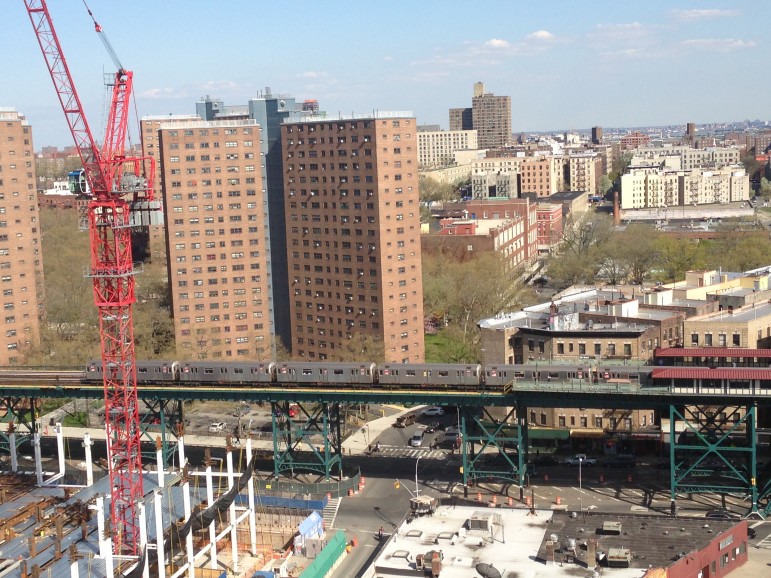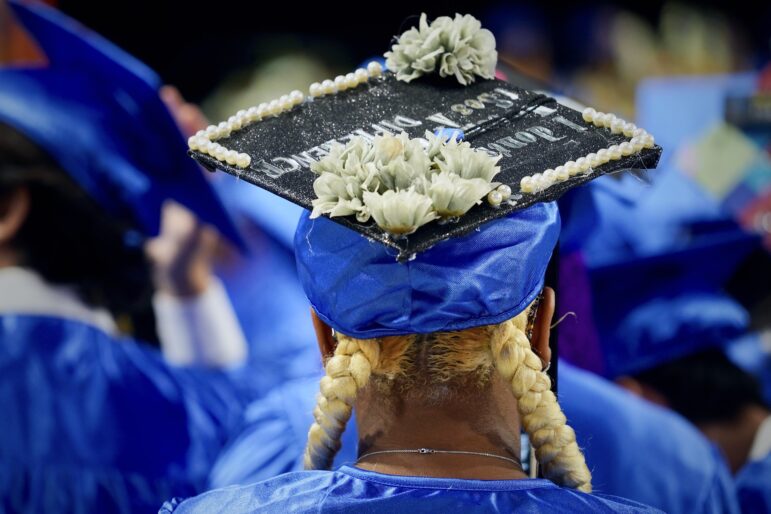
RegentsPark
Columbia's new campus rises in the foreground. The Manhattanville Houses are just beyond the elevated 1 train.
Last month the New Yorker ran a 12-page profile of Taylonn Murphy, community activist and the father of Tayshana “Chicken” Murphy, a celebrated basketball prodigy who was shot and killed four years ago in Harlem. Tayshana’s death reignited a violent feud between two Harlem public-housing complexes, the Grant and Manhattanville houses, that went back decades. Her death, however, drew not only a media spotlight but also police and prosecutors’ attention to young people from the area even faintly associated with the conflict. It all culminated in a big show of force in June 2014 when the NYPD conducted the largest gang raid in the city’s history, busting down doors and holding residents face down at gunpoint.
Beneath the surface, however, there had been pleas from area families and community voices that sought to diffuse the tensions by focusing resources and intervention work on the young people involved in the back and forth. That help never came and some point to millions of dollars that had been allocated for community investment as a wasted opportunity.
Grant and Manhattanville, on opposite sides of 125th street, along with a few surrounding buildings, were the targets of the June 4th police raid last year. Police commissioner Bill Bratton and Manhattan District Attorney Cy Vance announced 103 indictments as a result of the raid. Many of those were “conspiracy” charges (protested by families) originally designed to take down the mafia, and some were based largely on social media posts—an NYPD tactic known as Operation Crew Cut.
After the raid hit, Murphy and another community activist, Derrick Haynes, challenged the premise that the raids were in service of the community: “We asked the city for help and we got a raid.” Along with Haynes, a youth counselor and basketball coach, Murphy renewed efforts for sustained anti-violence work that focused on at-risk youth—in particular, a crisis center that would provide youth-based programming for Grant and Manhattanville.
Indeed, there had already been money set aside for community programming in West Harlem. A lot of money, in fact. In 2009, Columbia University brokered a community benefits agreement, or CBA, with the West Harlem Local Development Corporation (WHLDC) that provided $150 million in exchange for supporting Columbia’s expansion into the neighborhood. At places like Yankee Stadium and Atlantic Yards, CBAs have been controversial. Many say that promises from developers aren’t delivered.
Columbia’s CBA in West Harlem was preceded by years of community resistance to its expansion attempts going back to the 1960’s when the university was rocked by protests over its spread into the surrounding neighborhood. Protests over the institution’s growing footprint, and its contribution to Harlem’s ongoing gentrification, were renewed during the Bloomberg administration when the university started buying land and using eminent domain to clear other properties. Haynes believes the university learned its lessons from the past and used the CBA to grease wheels this time around.
Of the $150 million of CBA money, $76 million was marked for a “Benefits Fund” that made its way down to local community based organizations. Perhaps recognizing that Grant and Manhattanville were starved for funding, $3 million was set aside for the two developments, which were adjacent to Columbia’s new property. The Manhattanville-Grant Coalition was created to administer those funds.
Six years later most almost none of the money appears to have been spent. According to 2015 West Harlem Development Corporation (the group changed its name in 2013 from WHLDC to WHDC) financial report, just over $85,000 has actually made its way to Grant and Manhattanville. (A 2014 report by Columbia indicates that other elements of the CBA are at various stages of fulfillment).
Maritta Dunn, head of the Manhattanville-Grant Coalition, has admitted that CBA funds haven’t funded much of anything yet, telling the Columbia Spectator “We haven’t been as active as we wanted to be… [Just] because you have a lot of money, does not mean that you’re supposed to spend it frivolously.”
Kofi Boateng, executive director of the WHDC, has overseen the dissemination of grants from the CBA since 2012. Haynes says that Boateng, who has a background in finance, is “not understanding of the dynamics” of West Harlem.
Boateng counters that the WHDC has funded local groups and programs, including Haynes’, which had its grant cancelled at its halfway point because of “poor performance.” He says Haynes has often tried to “besmirch” him in an attempt “to get money from the West Harlem Development Corporation.”
Asked about spending so far by the Manhattanville-Grant Coalition, Boateng wrote: “Per the CBA, our role is to review and process requests from the Manhattanville/Grant joint benefits committee. However, we do not supervise the committee. So far, they’ve submitted a request for $85,000, and we’ve paid it.” Dunn could not be reached for comment.
For several years there have been questions as to whether the community benefits agreement has benefited the community. An attorney general’s investigation of WHDC’s work from 2009 hrough 2011—before Boateng’s arrival—found disarray and excessive spending on consultants. Grant guidelines for the WHDC were rewritten earlier this year to refocus on local organizations. According to published reports, 40 percent of grant recipients in the most recent round were from outside the community.
Susan Russell, a lawyer and former chief of staff for City Councilmember Robert Jackson, was one of the chief architects of the CBA. As chief of staff for Jackson, who represented the area, Russell was instrumental in negotiating the agreement with Columbia, but she now expresses frustration at how the WHDC, where she sat on the board, went about the process of delivering the promised benefits.
Russell is very frank about her view of the CBA to be, in spirit, a form of ‘reparations’ for the historically black West Harlem community from Columbia University, which she describes as an institution originally dedicated to “educating the children of slave-holders.” She says that “big developers must help communities that are disrupted by major construction projects.” She is critical of some of the programs the board funded, questioning whether they “would help lift the community out of poverty and support health, things that the community had envisioned.” Ultimately, Russell places a lot of the blame for the CBA’s problems with a “dysfunctional leadership” at the WHDC.
Haynes and Murphy point to a generational gap between the WHDC and the young people in the community. Establishment decision-makers, who often enjoy the support of older tenant association members, don’t value or understand juvenile-specific programming, the two men say. The neighborhood had already gone without a youth-centered space when the Manhattanville community center closed for five years, before the CBA existed, only to reopen and struggle to find funds. The center was eventually privatized, with several non-profits now operating out of the space.
Of the 6,000 or so residents that live in either Grant or Manhattanville, at least half are young people, Haynes estimates. During a 2008 tenants association meeting he was already predicting there would be repercussions for not providing for them. “If you don’t get a handle on this situation… If we don’t provide for these kids, somebody is gonna get killed,” Haynes told meeting-goers. And by the time the understaffed community center that had been closed for five years finally did get running, it was too late. The kids from Grant and Manhattanville didn’t want to come back, Haynes says. He, and others, feel that the violence that led to the tragedy profiled in the New Yorker and the 2014 raid is in many ways an outgrowth of the failure of local groups to invest in peaceful alternatives for youth at those developments—an especially glaring failure given that millions of dollars designated for that purpose sat in a bank account.
“The system broke down for these kids,” Haynes says. “It shut them outta afterschool, shut them outta the community centers and left them with no choice.” Left with little choice and nothing to do in a poor neighborhood, all that’s left is to fight for territory, he explains. For Murphy, delaying or stifling the ability of resources to get on the ground ensures violence, which he describes as the natural outgrowth of poverty and despair.
“Poverty is not just money, man”, Murphy says. “Poverty is poor community services. Poverty is poor education, poor outreach, poor mental health services. Poverty just doesn’t just lie with income. And what is manufactured from poverty? Violence. And that’s what we’re dealing with.”
Haynes and Murphy’s plans are in limbo. The strategically-located crisis center they’re trying to open up in a private building between the Grant and Manhattanville houses is waiting on word from the building’s co-op owners, longtime residents who own and run the building under the old Tenant Interim Lease (TIL) program. The resident-owners of the building are now having issues with the city’s Department of Housing and Preservation Development, which means Haynes and Murphy’s lease, a month-to-month arrangement, is up in the air.
Today, Harlem residents walk past Columbia’s multi-million dollar Jerome L. Green Science Center, which is scheduled to open later this year. The center sits across the street from the Manhattanville houses, which is not only struggling to find resources but can’t seem to even tap into its share of the CBA money. “That building is up. They’re working on that six days a week,” Haynes says of Columbia’s new state-of-the-art digs. “People are looking at this construction site every day and getting nothing in return.”








